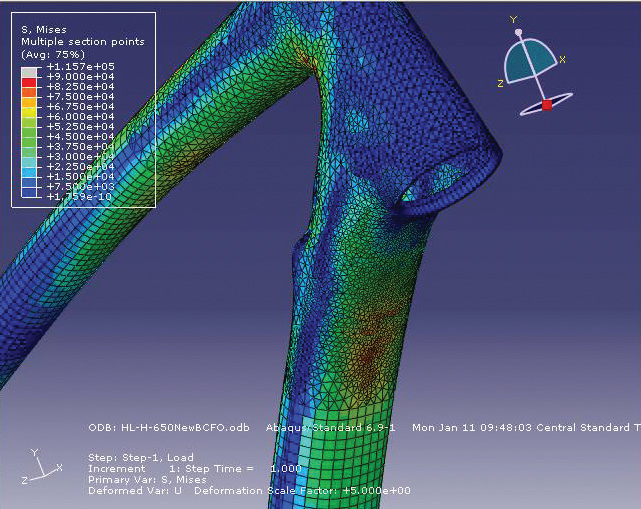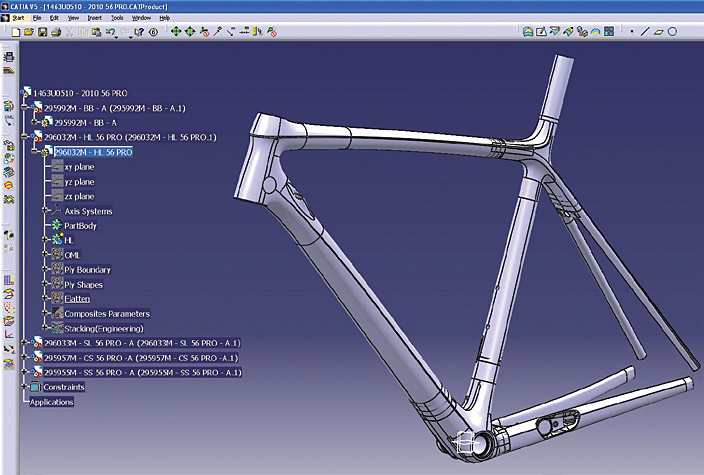
by Laura Carrabine, Senior Editor
Thursday, April 07, 2011

Trek Bikes is a global leader in the field of competitive cycling, offering some of the top-performing designs. Composite materials are an important part of making racing bikes light, fast, and strong. The company uses Dassault Systemes’ product lifecycle management (PLM) software to design and manufacture composite products that keep its bikes ahead of the pack.
The Madone full frame model is imported from Trek’s CAD system and used to place ply information on the 3D model for analysis using Simulayt and Simulia Abaqus software.
Trek unveiled its first molded carbon fiber frame in 1989. Today, the company produces stylish new designs with complex geometries that provide advantages unique to Trek. For example, the frame of its 2010 Madone bike is more than five ounces lighter than its predecessor, yet 17% stiffer for more confident handling at speed. Every 6 Series Madone is built with Trek’s sophisticated carbon fiber – OCLV Red, which improves performance but complicates lay-up processes and schedules.
“The multitude of innovations that our industrial designers and design engineers come up with force us to engineer increasingly more complicated and difficult composite frame solutions,” said Mark Wilke, chief process engineer-composites. “Traditional design and lay-up methods are not up to the challenge of creating innovation at the pace needed to maintain our leadership position.”
To save time, improve quality, and beat its competitors to market, Trek does design, virtual testing, and manufacturing process evaluation in a single, unified Catia environment. The ply layout is developed in Catia Composites Design (CPD) by creating ply tables and composite cross-sections. The finite element model is prepared within Catia Advanced Meshing Tools. Simulayt Composite Modeler provides bi-directional integration of the Catia Composites model into Simulia finite element analysis (FEA) software.

Wilkes added, “The seamless transition from Catia into Simulia makes it possible to analyze many more design concepts by eliminating the need for data translation. This helps us move lighter and stronger designs to market faster.”
Abaqus software analyzes the stiffness and load of different laminates to qualify frames to industry and Trek standards. Realistic simulation enables Trek engineers to compare the performance of multiple laminate designs virtually, and only send the best for physical prototyping and structural testing. This saves time and cost, yet allows Trek to try more laminate solutions than previously possible. Reducing the use of physical prototypes not only reduces time and costs, but also eliminates wasted materials and reduces energy use, critical considerations in Trek’s ongoing quest for improved sustainability and reduced environmental impact.
Simulayt’s Advanced Fiber Modeler that is integrated with Catia helps predict and correct fiber deformation in plies before the design is sent for cutting and lay-up. “In every case where we have used the new Catia-based composite design process, we have been able to evaluate multiple ply lay-up options, select the one that met strength and durability requirements, and validate the manufacturing process in a fraction of time,” Wilke said. “This iterative laminate development process is taking only two days, compared to two weeks in the past. This enables us to evaluate more design alternatives in less time.

“We have already used the surfacing capabilities in Catia to reduce the time needed to design manufacturing tools with complex curvatures. Catia’s surfacing capabilities will become more valuable as we use more complex shapes in our products. As a next step, we are considering implementing Catia for Mold and Die, which should enable us to perform mold design and manufacturing engineering in the same Catia environment for additional time and cost savings.”
Publicado en: http://www.designworldonline.com/articles/7146/245/Catia-Helps-Trek-Design-Green-Bikes.aspx
No hay comentarios:
Publicar un comentario